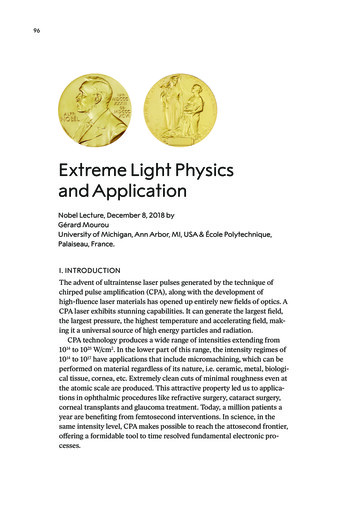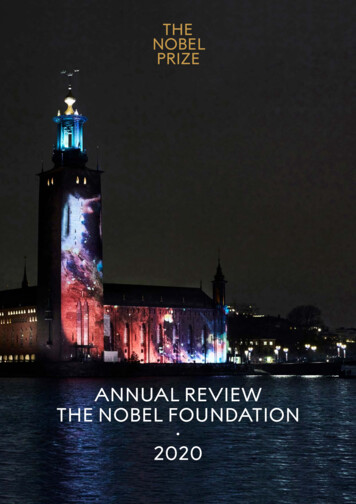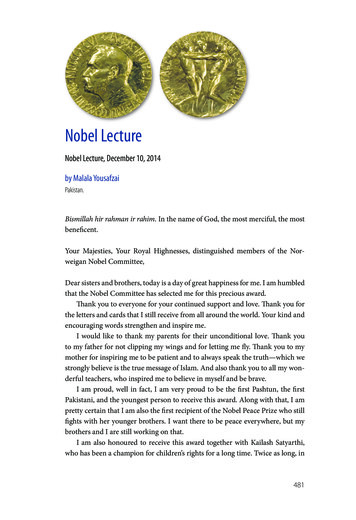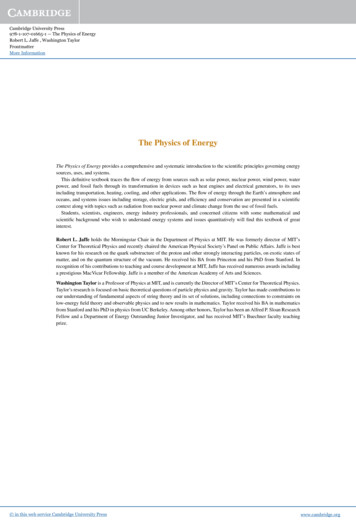
Transcription
96Extreme Light Physicsand ApplicationNobel Lecture, December 8, 2018 byGérard MourouUniversity of Michigan, Ann Arbor, MI, USA & École Polytechnique,Palaiseau, France.I. INTRODUCTIONThe advent of ultraintense laser pulses generated by the technique ofchirped pulse amplification (CPA), along with the development ofhigh-fluence laser materials has opened up entirely new fields of optics. ACPA laser exhibits stunning capabilities. It can generate the largest field,the largest pressure, the highest temperature and accelerating field, making it a universal source of high energy particles and radiation.CPA technology produces a wide range of intensities extending from1410 to 1025 W/cm2. In the lower part of this range, the intensity regimes of1014 to 1017 have applications that include micromachining, which can beperformed on material regardless of its nature, i.e. ceramic, metal, biological tissue, cornea, etc. Extremely clean cuts of minimal roughness even atthe atomic scale are produced. This attractive property led us to applications in ophthalmic procedures like refractive surgery, cataract surgery,corneal transplants and glaucoma treatment. Today, a million patients ayear are benefiting from femtosecond interventions. In science, in thesame intensity level, CPA makes possible to reach the attosecond frontier,offering a formidable tool to time resolved fundamental electronic processes.
Gérard Mourou LectureFor intensities 1018 W/cm2 laser-matter interaction becomes stronglydominated by the relativistic character of the electron. In contrast to thenonrelativistic regime, the laser field moves matter more effectively,including motion in the direction of laser propagation, nonlinear modulation and harmonic generation, leading to high energy particle and radiation production. One of the hallmarks of this regime is Laser WakefieldAcceleration (LWA), where the electromagnetic energy from a laser pulseis transformed into kinetic energy producing accelerating gradients athousand times higher than those applied in conventional accelerators.The electron beam can, in turn, produce a copious amount of keV radiation by betatron or Compton scattering.For intensities at 1025 W/cm2 the laser field becomes so large that protons and ions become relativist with GeV energies. The acceleration isdirectly produced by the light pressure. The source size is very small, andthe large acceleration gradients combine to make this source brightnessbetter than any existing.The coupling of an intense laser field to matter also has implicationsfor the study of the highest energies in astrophysics, such as ultrahigh-energy cosmic rays with energies in excess of 1020 eV. Intense laser fieldscan also produce an accelerating field sufficient to simulate general relativistic effects in the laboratory via the equivalence principle like the lossof information in Black Holes.Many CPA applications offer great benefit to humankind. We discuss afew examples capitalising on the compactness of the CPA-based source.For instance, the generation of high energy protons and neutrons appliedto the treatment of cancer, i.e proton therapy, or in nuclear pharmacologywhere short-lived radionuclides could now be created for therapy or diagnostics near the patient’s bed.In the environmental arena, owing to the efficient generation of highenergy neutrons, it is one of our goals to use them to shorten the degreeof radiotoxicity of the most dangerous elements, the minor actinides innuclear waste.Finally, looking onwards, particle production in “empty” space willremain one of the main objectives of the field. It is the historical path whichguided the field in order to acquire an understanding of fundamental questions on the structure of vacuums, to give us a glimpse of the propagationof light in vacuums and how it defines the mass of all elementary particles.A novel laser architecture to reach intensities at the Schwinger level isexplored. Its paradigm is based on the transition of a single cycle visiblelight pulse into a high energy single cycle X-ray pulse. Successful transposition would give the field a formidable boost, equivalent to the onereceived when maser transitioned into laser, moving from GHz to PHz(Light) frequencies.97
98THE NOBEL PRIZESII. THE CPA TECHNIQUEThe key to high and ultrahigh peak power and intensity is the amplification of ultrashort pulses in the picosecond and femtosecond time scales.Over the past 40 years laser-pulse durations have continuously decreasedfrom the microsecond domain with free running to the nanosecondregime with Q-switching, and finally to the picosecond and few-femtosecond regime with mode locking (Brabec and Krausz, 2000). With theadvent of mode locking, the laser-pulse duration became so short thatpulses could not be amplified without producing unwanted nonlineareffects. This caused a power and intensity plateau seen in Fig. 1. Before1985, for reasonable sized systems, i.e., with a beam diameter of the orderof 1 cm, the maximum obtainable power remained around 1GW, withfocused intensities of about 1014 W/cm2. Higher power could be obtainedthrough the use of amplifying media with gain bandwidths that canaccommodate the short pulse spectrum and high-energy storage mediathat have a small transition cross section σa. However, to be efficient, thisapproach requires the use of input pulses with a high laser fluence of afew J/cm2. As we shall see later, good energy extraction from an amplifiercalls for input pulses close to the saturation fluence, see Eq. 1. This levelof fluence delivered over a short time leads to prohibitively large intensities, in excess of TW/cm2. This is far above the limit of the GW/cm2imposed by the need to prevent nonlinear effects and optical damage inthe amplifiers and optical components. As a result, the only alternativeseemed to use low-energy storage materials such as dyes or excimers andincrease the laser beam cross section. The latter is unattractive as it leadsto large, low-repetition rate and costly laser systems. Therefore, high-intensity physics research was limited to a few large facilities such as theCO2 laser at Los Alamos National Laboratory (Carman et al., 1981), theNd:glass laser at the Laboratory for Laser Energetics (Bunkenburg et al.,1981), and excimer lasers at the University of Illinois at Chicago and University of Tokyo (Luk et al., 1989; Endoh et al., 1989).In 1985 laser physicists at the University of Rochester (Strickland andMourou, 1985) and later (Maine and Mourou, 1988; Maine et al., 1988),demonstrated a way to simultaneously accommodate the very large beamfluence necessary for energy extraction in superior storage materialswhile keeping the intensity and nonlinear effects to an acceptable level.This technique was called Chirped Pulsed Amplification (CPA). CPA revolutionised the field in three ways. First, a TW system could fit on a tabletop, thus delivering intensities 105–106 times higher utilising conventionaltechnology. Second, the CPA architecture could be easily retrofitted toexisting large laser fusion systems at relatively low cost. Today CPA isincorporated in all the major laser fusion systems around the world suchas: Japan (Yamakawa et al., 1991), France (Rouyer et al., 1993), United
Gérard Mourou LectureFigure 1. Laser intensity vs years.Kingdom Vulcan Laser, United States Perry et al., 1999, etc. Third,because of their reduced size CPA lasers could be combined with largeparticle accelerators. In the case of synchrotrons (Wulff et al., 1997; Larsson et al., 1998; Schoenlein et al., 2000), they could be used to studytime-resolved x-ray diffraction. With a linear collider such as SLAC onecould produce fields higher than the critical field (Bula et al., 1996) andobserve nonlinear QED effects such as pair generation from a vacuum. Atpresent all the colliders are considering the incorporation of CPA technology to produce γ rays for photon-photon collisions to produce a γ-γ collider, (Telnov, 1990, 2000, 2001; Yokoya, 2000).As we shall describe later, the availability of ultra-high intensity lasershas extended the horizon of laser physics from atomic and condensed-matter studies to plasma, nuclear, and high-energy physics, general relativity, cosmology, and physics beyond the standard model. It hasalso had a major effect in bringing back to university laboratories sciencethat formerly could only be studied with large-scale facilities. Also at arelatively low peak power level, it made precision machining and ophthalmic procedures in the medical arena possible.A. Amplification: The Energy Extraction ConditionBefore 1985 all amplifier systems were based on direct amplification. Asmentioned in the introduction, for extraction efficiency, a simple rule isthat the energy per unit area be of the order of Fsat, the saturation fluenceof the materials. This value is given by99
100THE NOBEL PRIZES(1)where ћ is Planck’s constant, ω is the angular laser frequency and σa isthe amplifying transition cross section. Fsat is 0.9 J/cm2 for Ti:sapphireand 4 J/cm2 for Nd:glass and of the order of a mJ/cm2 for dyes and excimers. It can be shown (Siegman, 1986) the output fluence Fout is given by(2)where G0 is the low signal gain and(3)(4)The gain Gf at the end of the impulsion is given by(5)From Eqs. 4 and 5 we see that, to reach an efficiency close to unity, thelaser input fluence Fpulse must correspond to few times Fsat. Fig. 2 illustrates this point for two different initial gains G0 of 10 and 103.
Gérard Mourou LectureFigure 2. Amplifier efficiency.This illustratesthe importancefor the inputpulse fluenceFpulse to be fewtimes the saturation fluenceFsat to obtain agood extractionefficiency.B. Amplification: The Propagation ConditionPrior to CPA the amplifying media were exclusively dyes, (Migus et al.,1982) and excimers (Endoh et al., 1989; Luk et al., 1989). Typical crosssections for these media are very large, in the range of 10 16 cm2, implyinga Fsat of only a few mJ/cm2, or a power density of 1 GW/cm2 for subpicosecond pulses. At this power density level, the index of refractionbecomes intensity dependent according to the well-known expression(6)Due to the spatial variation of the laser beam intensity, this will modifythe beam wavefront according to the B integral given by(7)Here, B represents, in units of λ, the amount of wavefront distortion dueto the intensity-dependent index of refraction, accumulated by the beamover a length L. For a perfectly Gaussian beam, B will cause the wholebeam to self-focus above a critical power given by101
102THE NOBEL PRIZES(8)For a nonlinear index n2 5 10 16cm2/W for Ti:sapphire. When the laserbeam exhibits spatial intensity modulations, n2 will cause the beam tobreak up in filaments. In practice the small scale self-focusing representsthe most severe problem in an amplifier system. The maximum growthrate gm (Bespalov and Talanov, 1966) will occur for spatial frequencies Kmgiven by(9)(10)For intensities of the order of I 1 GW/cm2 in Ti:sapphire, Km 200 cm 1,corresponding to 50 μm spatial wavelength. As seen in Fig. 3, these wavefront “irregularities” will grow at a rate of gm 3 cm 1 with an exponentialgrowth rate Gm over the gain length L exactly equal to B,Gm BFor laser fusion, the beam is “cleaned” with spatial filters every time Breaches 3. For high-field experiments in which the spatial and temporalbeam quality requirements are more stringent, B must be kept below 0.3corresponding to a wavefront distortion of λ/20.Figure 3. The intensity dependence of the Index of refraction, will create spatial variationof the laser beam intensity, producing undesirable filaments and hot spot.
Gérard Mourou LectureC. The CPA ConceptWe have seen that amplifying media with low cross sections offer thebenefit of compactness. For instance, Nd:glass has a cross section of 10–21cm2, which means that we can store 103 to 104 times more atoms per unitvolume and consequently, get 103 to 104 more energy before it self-oscillates, than with a dye or excimer with cross section 1016 cm2. However, toextract all the energy in a picosecond pulse would require a beam with afluence Fs of the order of 1 J/cm2 or an intensity of 1012 W/cm2 corresponding to a B of 103, or 103 times the acceptable value.Therefore, in order to utilise superior energy storage materials, thelaser scientist is confronted with the seemingly insoluble dilemma ofincreasing the input energy needed for energy extraction, while keepingthe input intensity at an acceptable level. This problem was solved by theCPA concept. First the pulse is stretched by a factor of 103 to 104. Thisstep does not change the input pulse energy and therefore does not affectthe energy extraction capability, but it does lower the input intensity bythe stretching ratio and hence keeps B to a reasonable level. Second, thepulse is amplified by 6 to 12 orders of magnitude, i.e. from the nJ to themillijoule or kilojoule level, before it is finally recompressed by thestretching ratio back to a duration close to its initial value, see Fig. 4.Figure 4. Chirped pulse amplification concept. To minimise nonlinear effects the pulse is firststretched several thousand times lowering the intensity accordingly without changing theinput fluence J/cm2. The pulse is next amplified by a factor of 106–1012 and is then recompressed by a factor of several thousand times closer to its initial value.D. The Key Element: The Matched Stretcher-CompressorIn the first CPA set up (Strickland and Mourou, 1985) the laser pulse wasstretched using an optical fibre with a positive group delay dispersion andwas recompressed by a pair of parallel gratings (Treacy, 1969), with a negative group delay dispersion. Although this first embodiment led to aspectacular 100-fold improvement in peak power, the problem was thatthe stretcher and compressor were not matched over all orders. As aresult, after recompression the pulse exhibited unacceptable pre-pulsesand post-pulses.103
104THE NOBEL PRIZESThis led the Rochester group to look for the ideal “matched stretcher-compressor.” It came in 1987, when Martinez (Martinez, 1987) proposed a grating compressor with positive group delay dispersion for communication applications as shown in Fig. 5. In communication systemsthe wavelength of choice is 1.5 μm, a spectral region where the fibreexhibits negative group velocity dispersion. After propagation in a fibrethe bits of information exhibit a negative chirp. It is therefore necessaryto use a dispersive delay line after propagation with a positive groupvelocity dispersion to recompress the pulses. After examining thisarrangement, the Rochester group came to the conclusion that the Martinez “compressor” was in fact the matched stretcher of the Treacy compressor that they were intently seeking. This can be easily shown by considering the arrangement shown in Fig. 5. When one uses a telescope ofmagnification 1, the input grating located at a distance f from the first lenswill be imaged at the same distance.Figure 5. Treacy and Martinez grating arrangements. The Martinez grating pair used asa stretcher and Treacy grating pair used as a compressor. It was discovered and demonstrated by Pessot et al., (1987) that these two grating arrangements are in fact matchedover all orders. The pulse can be stretched and recompressed arbitrarily keeping the initialpulse unchanged. This grating arrangement is used in most CPA systems.The phase conjugation properties of the ‘’stretcher/compressor’’ wereproposed and demonstrated in (Pessot et al., 1987) by stretching a pulseof 80 fs by a factor of 1000 using the Martinez arrangement and thencompressing it back to exactly the same value using the Treacy compressor.This demonstration represented a major step in chirped pulse amplification. This matched stretcher-compressor integrated into a CPA system was
Gérard Mourou Lectureto produce the first terawatt pulse on a table top system, the so-called T3 bythe Rochester group. It was subsequently used for subpicosecond pulseamplification (Maine and Mourou, 1988; Maine et al., 1988) and for a pulseduration of 100 fs by Pessot et al. (1989). This arrangement stands today asthe standard architecture used in CPA systems.E. New Materials for CPA, OPCPA and Gain NarrowingCPA was demonstrated initially with the two broadband-amplifyingmedia that were available at the time, Nd:glass and alexandrite (Pessot etal., 1989). Shortly after, this initial work the concept was extended toTi:sapphire (Vaillancourt et al., 1990; Kmetec et al., 1991; Squier et al.,1991; Sullivan et al., 1991) as well as Cr:LiSrAlF6 (Beaud et al., 1993; Ditmire and Perry, 1993) and Yb:glass (Nees et al., 1998). Among these materials Ti:sapphire has the advantage of the broadest bandwidth, with ahigh damage threshold and excellent thermal conductivity greatlyenhanced at cryogenic temperatures (Backus et al., 1997).Parametric amplifiers have also been proposed and demonstrated byDubietis et al. (1992). It was used for large scale laser applications at theRutherford Appleton Laboratory (Ross et al., 1997, 2000). This eleganttechnique, called OPCPA for Optical Parametric Chirped Pulse Amplification, is able, if the nonlinear propagation effects are kept under control, toprovide an extremely large gain bandwidth. It offers the great advantageto be pumped by large-scale laser systems dedicated to laser fusion.OPCPA could be the natural companion of any large laser fusion system.A more detailed discussion of the OPCPA method is provided below.In a conventional CPA system, one of the limitations in pulse durationcomes from gain narrowing. Because of their wide spectrum, short pulsescan be amplified only by materials with a gain bandwidth greater than thepulse spectrum. We note that materials with superior energy storage typically have a low transition cross section and broad gain bandwidth. However, large gain will lead to a reduction of the laser spectrum as it is amplified and therefore a longer output pulse. In the unsaturated regime – thelinear regime – the laser spectrum will be subjected to a narrowing given by(11)where Δωa is the gain bandwidth and G(ωa) the exponential gain. A gainof ten orders of magnitude will narrow the gain bandwidth by a factor of 3to 4. A fraction of this gain, however, can be recovered in the saturatedsection of the amplifier.105
106THE NOBEL PRIZESF. “CAN” a Novel ArchitectureMany applications involving high peak power, like high energy particleacceleration or transmutation of nuclear waste crucially need averagepower. They typically need peak power in the PW range with MW averagepower and excellent efficiency near 50%. Right now, a typical laser provides PW peak power but only with around tens watts average power and0.1% efficiency. A far cry from what we would need for real applications.To mitigate this problem, we proposed to build a novel amplifier basedon a multitude (network) of phased fibres, called Coherent AmplifyingNetwork (CAN). In a CAN fibre amplifier (Fig. 6) the active gain mediumis confined within the core of the optical fibre. Fibres benefit from efficient heat removal due to the advantageous volume to lateral surface area.It can also be pumped efficiently by a laser diode that is well-tuned to thefibre. Hence the CAN laser could provide simultaneously, peak power,average power and efficiency. Continuous-wave fibre lasers with averagepowers in the kilowatt regime were first demonstrated in 2004.Figure 6. CAN system is a fibre-laser based system built out of thousands of fibre laserscoherently added to increase the average power and pulse energy linearly. The fibrelaser offers excellent efficiency ( 30%) thanks to laser-diode pumping and provides amuch larger surface cooling area, therefore making operation at high peak power andhigh average power possible with good efficiency and pristine beam quality.
Gérard Mourou LectureNote also that CAN uses the CPA concept. An initial pulse from anoscillator laser is stretched and split into many fibre channels as many as104. Each channel is amplified in several stages, with the final stages producing pulses of 1 mJ at a high repetition rate. All the channels are combined coherently, compressed and focused to produce a pulse with a possible energy of 10 J at a repetition rate of 10 kHz. Of course, the cost ofthe system will be expensive but at this level any system will have a significant cost.G. The Quest for PW Peak PowerAs soon as the CPA concept was demonstrated at the millijoule andjoule levels, it became clear that it could be extended to much higherenergies using already built laser fusion systems to amplify nanosecondpulses in the 100–1000 J range. This means that with remarkably fewalterations, that is, by chirping the pulse at the input and compressing itat the output, a laser chain built to produce TW with ns duration pulsescould now produce petawatt PW with ps duration pulses (Maine et al.,1987).The first experiment started at the CEA-Limeil on the oldest laserfusion system P102 in the early 1990s. The laser was capable of producing on the order of 100 joules in the nanosecond regime. A seed pulseprovided by an oscillator was stretched amplified to several tens ofjoules and compressed to its initial value with the grating pair compressor. Of course, the main difficulty was the fabrication of the gratingswith a decent damage threshold and efficiency that could handle thelarge pulse energy. The largest gratings at the time, 30 cm x 40 cm, werefabricated and integrated to the system. These first gratings were produced by Jobin-Yvon, now Horiba, with reflectivity of 90% and a damage threshold of 0.1 J/cm2 and proved sufficient for a convincingdemonstration of high energy CPA.With P102 retrofitted in CPA, we produced successfully 20 TW (Sauteret et al., 1991); and later 50 TW (Rouyer et al., 1993). Similar result fewmonths later where obtained independently at ILE in Japan by Yamakawaet al. (1991). These results showed clearly that the CPA could work at anyarbitrary energy level and would be capable to produce PW pulse. Indeed,as we predicted, the first Petawatt pulse was demonstrated by Perry et al.(1999), ten years after the first terawatt. One of the impressive hurdlesovercome by Perry’s group was the fabrication of meter-size diffractiongratings. They revolutionised the field.107
108THE NOBEL PRIZESFigure 7. World map of lasers with peak power 100TW.In parallel to the Nd:glass based petawatt systems, we have today a number of high-power Ti:sapphire-based systems. They exhibit much shorterpulses in the 20–30 fs range, and energies in the 5–10 J range, thus delivering peak power of 100 TW. A 100 TW class Ti:sapphire laser was firstdemonstrated at the University of California at San Diego (Barty et al.,1994). The leading laboratories at the present time in this area areCoReLS Research Center, in Korea, APRC in Japan with around 500 TW(Aoyama et al., 2002), Janus System at Lawrence Livermore, 200 TW, theLaboratoire d’Optique Appliquée (LOA) in France with 100 TW, the MaxBorn Institute in Germany with 100 TW, the Lund University in Swedenwith 30 TW, and the Center for Ultrafast Optical Science University ofMichigan with 200 TW. Today nearly one hundred 100 TW systems areoperating (Fig. 7) with about 20 systems at the PW level (Fig. 8) existingor under construction. Groups in China (SIOM), Russia (APC), and theUSA (LLE) are now aiming at the 100 PW level.Figure 8. World map of lasers with peak power 1PW.
Gérard Mourou LectureH. Optical Parametric Chirped Pulse Amplification (OPCPA)In this section we discuss the differences between the CPA and OPCPAmethods. Fig. 9 shows the conceptual layout of an Optical ParametricCPA, OPCPA system (Dubietis et al., 1992; Ross et al., 1997). Because weare reviewing only relativistic intensity laser we will not mention the largenumber of projects related to the sub-relativistic regime using OPCPA. Asin CPA the objective in OPCPA is to stretch the pulse to a nanosecondduration and then amplify it to the joule or higher level by optical parametric amplification and recompress it back to close to its initial value.Note that the stretching is essential not only to keep the B integral low butalso to pump and extract the energy efficiently. It is only during thestretched pulse that light can be transferred from the pump beam to thesignal beam. Consequently, the pump pulse duration and that of thestretched pulse must be as equal as possible. The advantages of this technique are as follows:1. Large bandwidth that could accommodate few-cycle pulses.2. Ability to benefit from very large KDP crystals (100 100 cm2)developed for laser fusion.3. Adaptability to existing laser fusion chains, which benefit fromlow-bandwidth well collimated nanosecond laser pulses at 532 nm.4. No heat dissipation in the OPA crystal itself, this is important forhigh average power.5. No transverse amplified stimulated emission, which is a majorsource of loss for large-aperture Ti:sapphire systems.6. Ability to use an iodine laser as a pumping source.7. Very simple amplification system.Figure 9. OPCPA concept. In the OPCPA the pulse is amplified by optical parametricamplification instead of regular optical amplification. Note that for efficiency the pumppulse and the stretched pulse must have approximately the same duration and the samespatial extend.109
110THE NOBEL PRIZESThe disadvantages are as follows:1. Lower efficiency than standard CPA. For a standard Ti:sapphireCPA, the efficiency can be as high as 50% from a long green pulse,say of 50 ns. The energy storage time of Ti:sapphire is 2 μs. So CPAis overall a more efficient system.2. Very large stretching ratio, in the range of 106 to 1, i.e. 10 fs to 5 ns,necessary for energy extraction. This will make pulse compressiondown to the 10 fs regime difficult.3. Gain is a significant function of the intensity. This means the pumpbeam profile may affect the beam quality and needs a high level ofcontrol.In both systems, the pulse duration will ultimately be limited by the grating bandwidth. At present no large gratings have the efficiency and thebandwidth necessary for efficient pulse compression much below 30 fs.Beam quality from CPA has been demonstrated to be excellent. The lateststudies have shown that OPCPA can also provide good spatial beam quality (Collier et al., 1999). The potential of this technique has been demonstrated with the production of a 35 J, 85 fs pulse, equivalent to 0.4 PW,using a 10 cm-diameter beam (Collier et al., 2004). The possibility ofreaching high energies seems to be more straight-forward with theOPCPA because it can benefit from kJ, ns fusion lasers that are already upand running. The pulse duration, however, will be limited by the gratingbandwidth. CPA implementations must wait for large Ti:Sapphire crystalsgrown to 20 20 cm2 dimensions. These larger-scale crystals shouldbecome available as the demand for higher peak power increases.III. BEYOND THE HORIZON: THE ZEPTOSECONDAND EXAWATT DOMAINIn their pioneering experiment Grischkowsky and Ballant (1982) used asingle mode optical fibre and were able to compress a picosecond pulsewith nJ energy to the femtosecond level. This work triggered an enormous interest. To go higher in energy Orazio Svelto and his group (Nisoliet al., 1996) introduced a compression technique based on a fused silicahollow-core capillary, filled with noble gases to broaden the pulse spectrum before efficiently compressing to the 100 μJ level with chirped mirrors that introduce negative dispersion to the pulse phase. Refining thistechnique Orazio Svelto, Ferenc Krausz and collaborators (Nisoli et al.,1997) could compress a 20 fs into 5 fs or 2 cycles of light at 800 nm.For higher energy, bulk compression was attempted by Rolland andCorkum (1988). In their implementation, the pulse is free-propagating in
Gérard Mourou Lecturea solid and not guided anymore. The pulse was relatively long, around 50fs, with an input energy of 500 μJ leading to an output pulse of 100 μJ in20 fs. However this scheme is impaired by the beam bell shape intensitydistribution. This leads to variation in the nonlinear response across thebeam profile and a corresponding variation of the compression factor.Figure 10. This element uses auniform thickness plastic elementof around .5mm. An incident flattop pulse will induce a uniformself-phase modulation across theelement. After spectral broadening the pulse is compressed by2 chirped mirrors to a near singlecycle pulse into a 2.1 fs after twocompression stages.A. Large Energy Pulse Compression: Thin Film Compression (TFC)Recently we have proposed a technique (Mourou et al., 2014) to compress25 fs large energy pulses as high as 1 kJ to the 1–2 fs level. We call thisapproach the Thin Film Compressor, or TFC, and its principle is shown inFig. 10. As shown in our simulation, this method is very efficient 50%and preserves the beam quality. Here the technique relies on the flat topnature of the high energy pulse and uses a thin “plastic” film of 500 μmwith a diameter of 20 cm. The element, that we call plastic for simplicity,will be transparent and exhibit a uniform thickness. The modelling of thepulse propagation leading to spectral broadening due to the nonlinearprocesses that occur within the film is described in Akhamov et al. (1992).After spectral broadening the pulse is compressed by chirped mirrors to anear single cycle pulse showing a pulse of 2.1 fs after two compressionstages. This represents the shortest pulse duration that can be achievedbased on the limitation defined by the laser wavelength, λ. Once the pulseis focused on λ2 the pulse is in the desired λ3 regime. The λ3 regime is thefocus volume that achieves the highest intensity for a given pulse energy.In order to increase the intensity, it is necessary to shift to shorter wavelengths that can support shorter pulse durat
sat. is 0.9 J/cm. 2. for Ti:sapphire and 4 J/cm. 2. for Nd:glass and of the order of a mJ/cm. 2 . for dyes and exci-mers. It can be shown (Siegman, 1986) the output uence F. out. is given by (2) where G. 0. is the low signal gain and (3) (4) The gain G. f. at the end of the impulsion is given by (5) From Eqs. 4 and 5 we see that, to reach an e .










